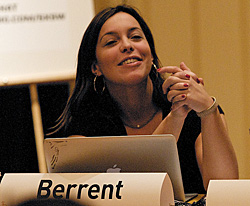
Guest post by Amy Sample Ward
amysampleward.org
Earlier this month, Samsung Hope for Children, the national philanthropic initiative of the Seoul-based tech company, and the Dan Marino Foundation launched a new social action campaign, “Team Up for Autism,” in conjunction with the first annual WalkAbout for Autism organized by the foundation started by the former Miami Dolphins quarterback. The initiative set about to help raise awareness and funding in support of medical research, services and treatment programs for children with autism.
Samsung pledged to contribute up to $100,000 through this social action challenge, providing a donation of $5 to the Dan Marino Foundation each time someone pledged their support of autism awareness by sharing an infographic with their Facebook friends or sending a tweet with the hashtag #teamautism. And in just 72 hours, they reached their goal of $100,000 through TeamUpForAutism.com.
That’s a whole lot of donations in just three days! So, I connected with Sloane Berrent, founder of The Causemopolitan and a partner in Socialbrite, to learn more about this success story. She’s working with the creative agency JESS3 on this entire campaign. They created the infographic and pulled her in for the overall digital strategy.
Going into the campaign, did you really expect to hit your goal in just three days? What were the goals and expectations you had set for the campaign internally?

That said, this time around, Samsung, the Dan Marino Foundation and JESS3 were looking for more bite. The goal was $100,000 and we were given a month but were definitely hoping for two weeks. It was absolutely amazing to reach our goal so quickly, and it’s because of all of the hard work we did beforehand that it happened. That and a bit of groundswell.
What kind of post-campaign planning did you do before launching?
Sloane Berrent: We really focused on building our team of advocates before we launched the campaign. I know a lot of campaigns where people feel that you launch and put it out there and then you bring people in and have them share in the experience. But for this campaign we really baked them in early. We contacted autism advocates and let them know this campaign was coming.
We didn’t have all the pieces finished, but we drafted outreach and pulled together lists. It’s really important to be prepared when you hit the gate. Sometimes campaigns change when they’re live and that hard work you put in gets discounted and sometimes it makes all the difference. It’s not a gamble, though. You have to do the work, identify your target groups and know who your advocates are. You have to pay attention to what happens in that first 24 hours and be willing to change your strategy to fit what the market is telling you because you never really know what’s going to happen with a campaign until it’s live.
How do you see the social media engagement and outreach involved in this campaign impacting the post-campaign social media use by the Foundation?
Sloane Berrent: We really worked on educating Dan Marino and the Dan Marino Foundation on how to effectively use social media. They both were aware of what was out there, but we talked a lot about engagement and creating conversation. Both have seen a rise in their numbers of followers and fans and sometimes that quantity helps to get to quality. I don’t think nonprofits should have to fight tooth and nail for every follower. Spikes like this campaign are good for nonprofits, and then they can back into these tools and find a way that works for their bandwidth on a day-to-day basis.
To others looking at your success as an inspiration for their own campaigns and fundraising plans, what tips or recommendations would you share?
Sloane Berrent: Thank people one time too many. I’m serious! Say thank you and then say thank you again. That’s a bit of secret sauce but you can never say thank you enough to people who do things for you because they want to and not because they’re paid to or work for you. That’s a powerful change agent.
It’s like the idea of second gifts. Someone makes a gift, they get a thank you and then they make a second gift because they were impressed with the thank you. It’s a cycle. When people feel recognized and valued, truly valued, they are willing to go to bat for you. Social media is complicated and wily at times, sometimes you’re the hare and sometimes you’re the tortoise. But the key is bringing your supporters along with you to your next campaign. Then success will follow you because people love being a part of not only your cause but the feeling they get from helping your cause.
Other campaigns: Lessons to share?
Has your organization looked to partner with another organization or a company for a campaign the way the Dan Marino Foundation partnered with Samsung, with dedicated matching funds? Have you tried a Twitter campaign with donations per tweet? What lessons would you share – what questions would you like to ask Sloane?
Republished from amysampleward.org.








